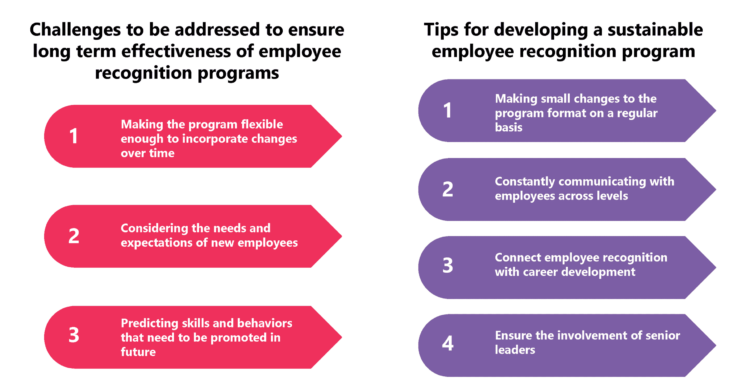1. Adapt to Workforce and Business Changes: Regularly update recognition programs to align with changing workforce demographics, business strategies, core values, and industry best practices.
2. Utilize the Right Technology: Choose a flexible recognition platform that can easily incorporate new features and adapt to evolving business needs.
3. Benchmark and Measure Continuously: Regularly benchmark the program against industry standards, measure its effectiveness, and act on any decline in impact.
4. Incorporate Employee Feedback: Develop systems for capturing employee feedback and maintain an updated roadmap to ensure the program remains relevant and practical.
Organizations today must maintain high levels of employee motivation and make them feel integral. A well-developed and implemented employee rewards and recognition program can be critical in this context. However, the effectiveness of employee recognition programs must be sustained over a long period.
Employee recognition is the key to ensuring greater employee engagement and keeping the workforce motivated and inspired.
Hence, by acknowledging and appreciating the efforts and achievements of employees, organizations can make them feel valued.
However, there are several reasons why well-designed employee rewards and recognition may fade over time.
So, let’s explore the top reasons for this:

The growing proportion of millennials in the workforce challenges organizations to sustain the effectiveness of recognition programs.
The needs and expectations of this workforce segment are significantly different from those of previous generations.
So, over time, as millennials increase as a proportion of the workforce, programs originally developed for previous generations might suddenly become irrelevant.
For example, an employee rewards program based on pre-paid cards might have been in vogue till about 2015.
But, a mobile app-based digital recognition platform is the most desirable today.

Over time, massive changes have occurred in the business environment in which the organization operates.
Hence, these changes prompt significant changes in business models, target markets, globalization, strategies, etc.
An employee rewards and recognition program once aligned to the original business goals of the organization might have become irrelevant.
For example, the organization’s original business strategy might have focused on the domestic market.
Today, it might be a global one doing business worldwide and having a presence in multiple countries.
Hence, the original rewards and recognition program design might not be able to cater to the needs of a global business and workforce.

An organization’s core values can also change over time. They are closely linked to the organization’s vision, mission, and business strategy.
These may evolve, prompted by the business environment. Changes in the organization’s top leadership might also bring about changes.
Hence, an employee recognition program must be closely aligned with the core values of the organization.
Recognition can help reward employee behaviors aligned with core values and reinforce them in the workforce.
The recognition program will likely lose relevance if the core values change over time.

Also, technological changes and consumer behavior over time can make a well-designed employee recognition program lose relevance.
A case in point is the advent of social media in all facets of work and life.
An employee recognition program designed years earlier might have ignored the importance of integration with social media. Hence, such a program is likely to have become ineffective in today’s context.
Also, older employee recognition programs might have operated in isolation without integrating with other work systems.
Today, it is imperative that employee recognition systems are integrated with learning management systems, project management systems, customer management systems, and workplace collaboration tools such as Teams and Slack.
Organizations must manage recognition programs accordingly as they face the challenges of sustaining their effectiveness over time.

The following are some of the best practices that organizations can adopt to sustain the effectiveness of employee recognition programs:

The choice of the employee recognition platform is critical to the entire journey over time.
A good platform can enable changes to be done easily to keep pace with the changing business requirements.
Additionally, it can help the organization incorporate industry best practices and advanced features into the program.
So, if the current platform is not flexible enough or doesn’t provide product upgrades, the organization can consider replacing it.

When an organization implements a new recognition program, it usually does substantial research about what is happening in the industry.
However, this one-time market study and benchmarking are not enough. Hence, if the organization studies other programs regularly, it will be able to stay abreast of the changes.
The organization could then proactively implement changes in its program before losing its relevance and effectiveness.

Measuring the benefits of the program on employee satisfaction, productivity, and retention can give early warning signs of any downtrend.
Any program effectiveness dip should be analyzed and acted upon by making appropriate changes.

It is critical to seek regular employee feedback and input based on their experience with the recognition system.
Such inputs can help tweak the program occasionally, keeping it relevant for the employees.
Short feedback surveys of employees can help with the necessary data required to understand the areas of improvement.

Additionally, the organization should keep studying other industry recognition programs and seek feedback and input from its employees.
It should monitor any drop in the program’s effectiveness. Based on these inputs, the organization should update the program roadmap regularly to plan for necessary changes.
Hence, the organization should work closely with its employee recognition platform vendor to plan and execute such changes.
In today’s fast-changing world, even the most well-designed employee recognition program cannot stand the test of time. It cannot deliver the same level of effectiveness without any significant changes.
The above best practices can help an organization to extend the program’s validity and usefulness over a long period and still derive the benefits of a highly engaged workforce.
Changes in the program are required to ensure the long-term effectiveness of employee recognition programs.

Lead author: Sagar Chaudhuri, the Co-Founder and CEO of HiFives. He is an HR Tech Evangelist with over 25 years of corporate and entrepreneurship experience. In the past, Sagar has worked in leadership roles with companies such as Genpact, Infosys, and ICICI Bank. He has an engineering degree from IIT Kharagpur and an MBA from IIM Lucknow. Connect on LinkedIn
To stay updated on the latest HiFives blogs, follow us on Twitter (@MyHiFives)